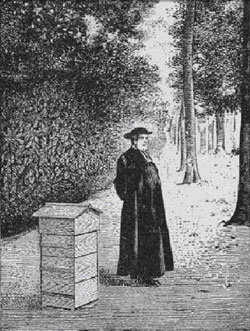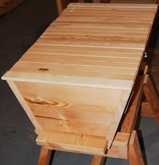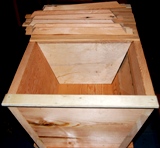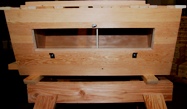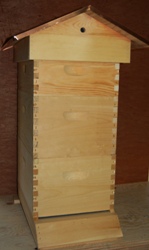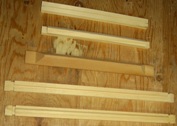Ruhl Bee Supply
Top bar beekeeping is gaining increasing interest in the northwest. It is often associated with the horizontal top bar hive, which comes in two main styles: the Kenya or Tanzanian hive. Top bar beekeeping is also done in vertical hives using the Warre or the Langstroth format. In fact when left to their own devices, bees prefer to build vertically, rather than horizontally (think bee tree). The common attribute of these various types of top bar hives is they do not use a starter comb. Instead they use just a top bar that allows the bees to build their comb from scratch. The result is beautiful combs having inherently organic shapes.
The top bar hive tends to be associated with simpler and more organic approach to beekeeping. However, it is a mistake to think you must use topbar hives to practice organic beekeeping. We are seeing this same organic approach being applied by an increasing number of beekeepers, regardless of the hive format. One main departure between topbar and conventional beekeeping is in the harvesting phase. The bulk of harvesting equipment (often expensive) is not set up for topbar combs, so top bar beekeepers generally use simpler harvesting methods.
Horizontal Topbar Hives:
Kenya:
The most popular horizontal top bar hive, the Kenya hive, has sides that slope inward toward the bottom. This is thought to be similar to the form found in natural combs. Generally, topbar combs should not be tilted if you remove them from the hive for inspection. If you do tilt the comb it can easily detach from the top bar, thereby causing much damage and disruption to the hive. In the Kenya hive the narrowing of the comb toward the bottom somewhat reduces the strain on the comb if you do tilt it, making it a little less likely to break away from the top bar.
One of the great frustrations of horizontal topbar bar beekeeping is that there is no standard for its dimensions (height, width, length slope). This makes it hard to exchange combs with other beekeepers, and hard to use much of the beekeeping equipment available for standard hives.
One of the great attributes of the horizontal top bar hive is that you do not need to lift hive boxes throughout the active season. While Langstroth beekeepers manipulate their hive at the box level and comb level, horizontal top bar beekeepers manipulate combs only. This is wonderful if you cannot lift much weight.
Honey harvesting is normally done without using an expensive centrifugal honey extractor. Instead, the beekeeper just crushes the honeycomb in a cheesecloth and let it drip through cheesecloth. Less efficient but less expensive, and quite effective.
Tanzanian
This horizontal top bar hive is essentially the same as the Kenya hive but its sides do not slope in. If made wide enough, it could fit Langstroth size top bars, allowing you to exchange frames with other Langstroth beekeepers. Be careful when lifting out the combs. They are the more prone to detaching from the top bar if tilted.
Vertical Topbar Hives
Warre
Born in France in the late 1800s, L'Abbé Eloi François Émile Warre developed "La Ruche Populaire" (the peoples hive) in an attempt to develop a simpler, less intrusive form of beehive management. The result is a vertically oriented top bar hive that incorporates, a special "quilt board" for natural insulation combined with some ventilation techniques. He espoused expanding the hive downward as the colony increases, and he espoused a minimum intrusion philosophy. Warre hive boxes generally have eight frames, and tend to be smaller than Langstroth hives.
Langstroth
By far the most widely used hive format in the North America, the Langstroth hive has become a de facto standard in much of the western beekeeping world. It comes in 10-frame or 8-frame size, deep sizes or medium. Although most commonly used with frames and starter foundation for the combs, it can just as easily be used for top bar beekeeping. If you cannot lift heavy weights, try using 8-frame medium boxes. If you want to reduce the size of your hive boxes, and practice topbar beekeeping, this is a great approach that will allow you to exchange combs with fellow beekeepers, install nucleus hives, and use all the equipment on the market that is generally priced to reflect the high volume of use.
Various top bar types. The lower two fit in Langstroth hives. #1 is a top bar with a beveled ridge for the bees to build comb, #3 has a center slat dipped in beeswax. #4,#5,#6 are similar but fit proprietary sized top bar hives. There is no size standard for top bar hives.
Kenya topbar hive with topbars exposed.
Kenya topbar hive viewing windows are fun, and reduce need for intrusion. Cover them when you are done viewing. Bees don't like being exposed to light in the hive.
Follower
board
Kenya top bar hives use follower boards to manage hive growth.
This 8-comb hive is configured as a Warre hive with top bars, quilt board and ventilated roof and bottom board; it can also be configured as an 8-frame Langstroth hive.
Emile Warre next to
"La Ruche Populaire."
#1
#2
#3
#4
#5
Visit our new retail store:
29600 SW Seely Ave Suite B
Wilsonville, OR 97070
Or call us: 503-657-5399
Ruhl Bee Supply
a proud division of Brushy Mountain Bee Farm


